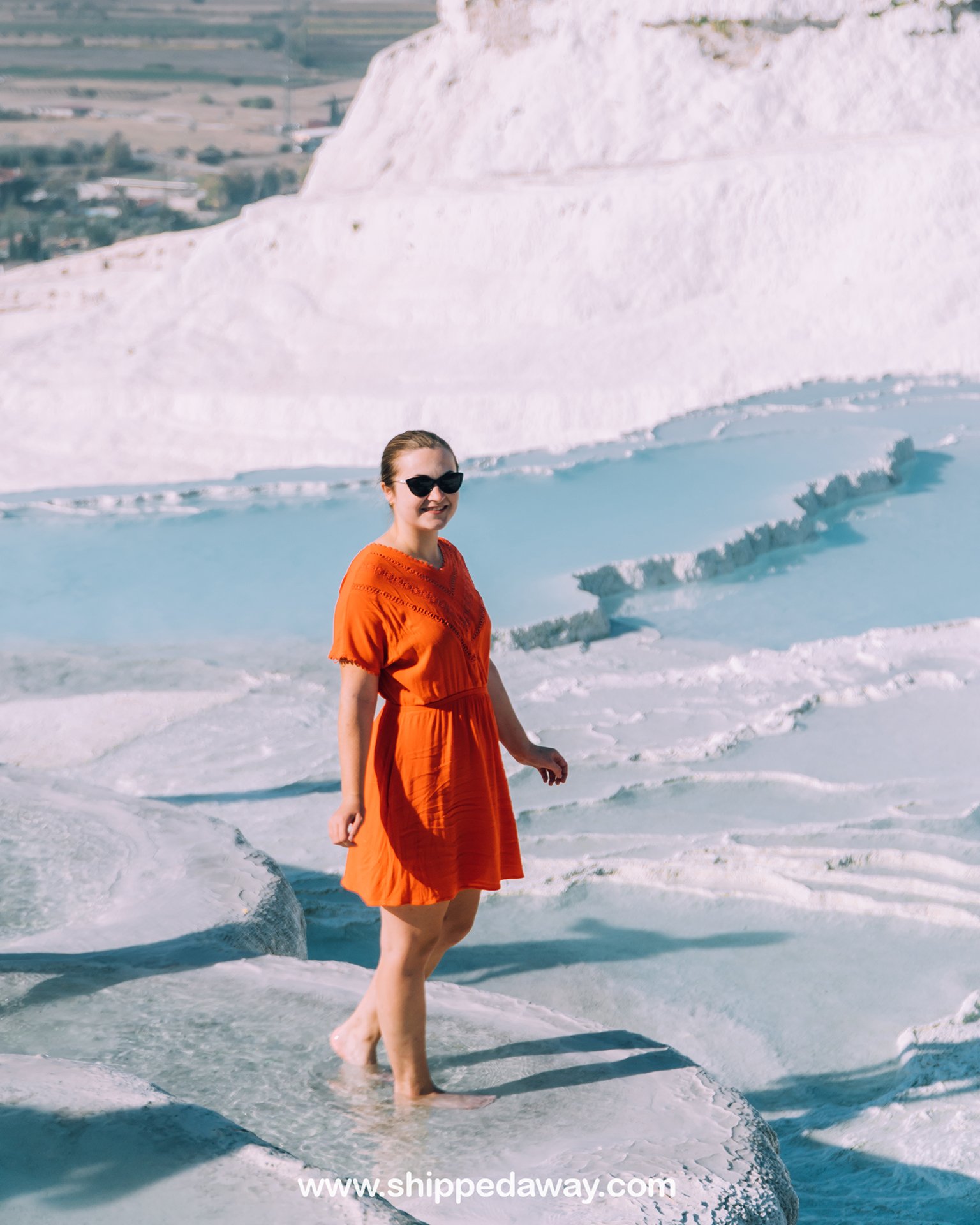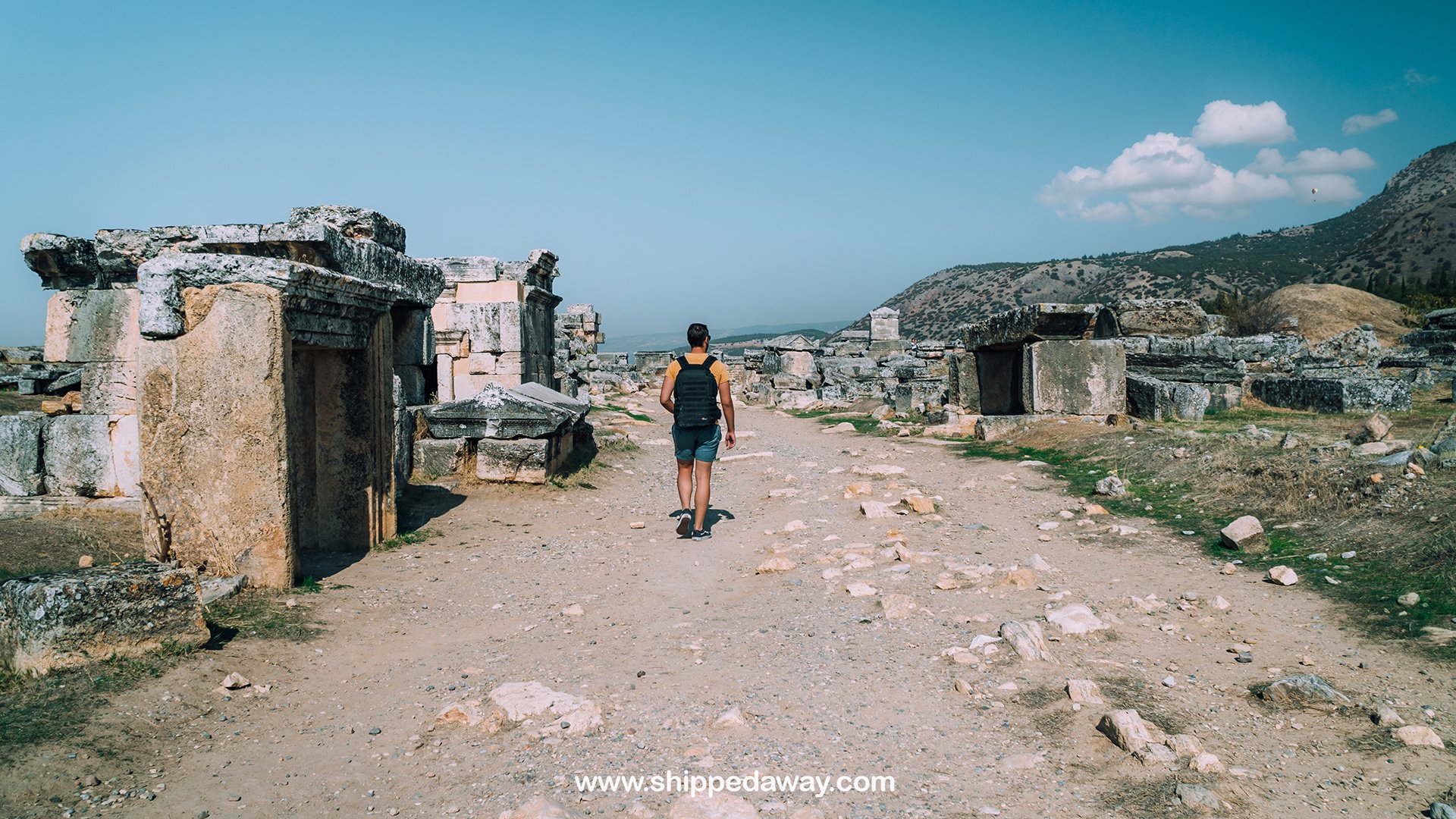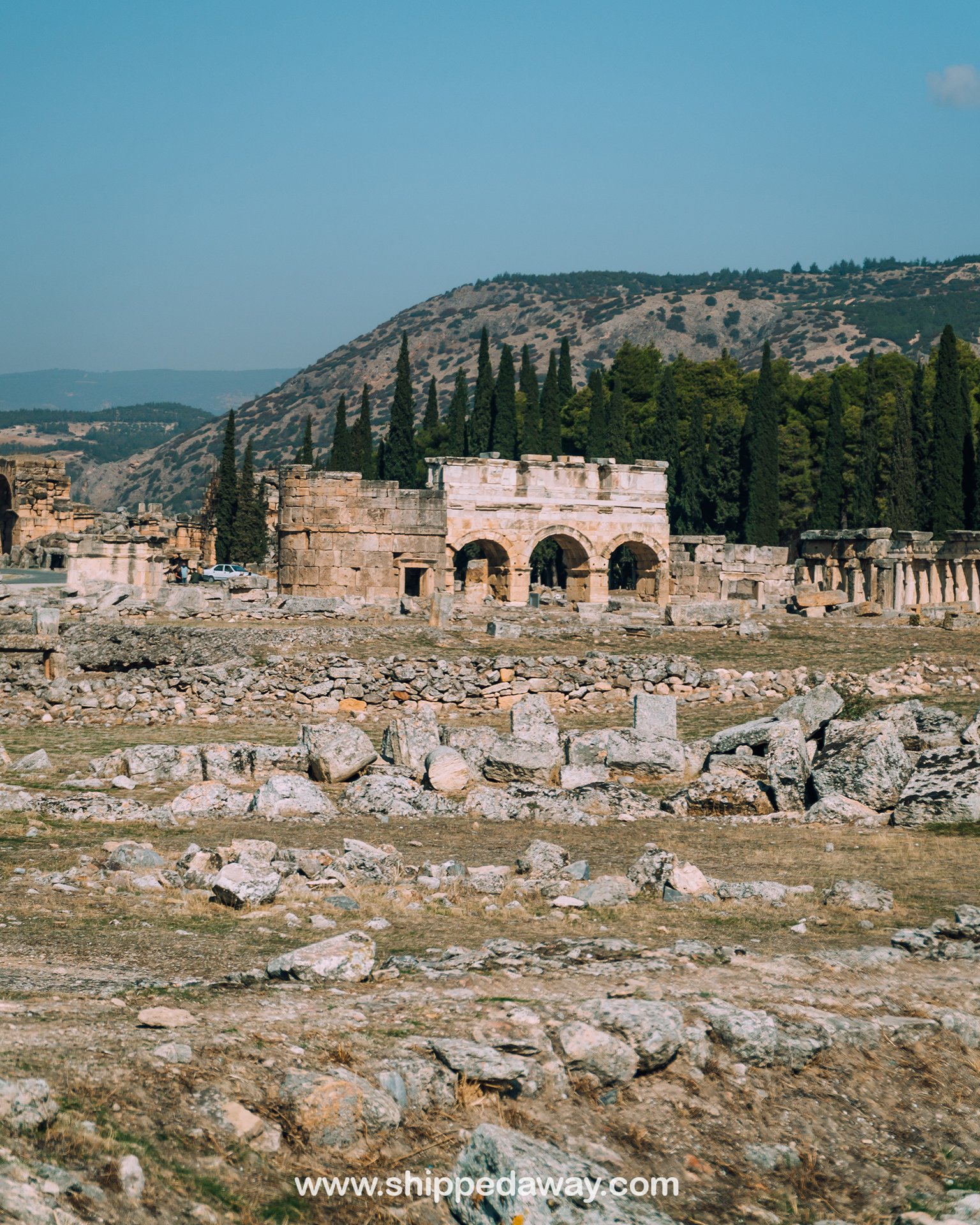The Travertines of Pamukkale are one of the bucket list spots in Turkey, so we had to visit it ourselves on our big Turkey Road Trip. While we ended up being a bit underwhelmed during our visit due to how social media portrayed this place, we don’t necessarily regret visiting.
But we decided to write this Pamukkale travel guide so you know exactly what to expect when you visit and can decide for yourself if it’s worth it.
About Pamukkale
Pamukkale and Hierapolis are two fascinating attractions in Turkey protected under the UNESCO World Heritage. Pamukkale is famous for the incredible white travertine terraces on which Hierapolis, once a major center of trade and culture, sat atop.
Good to know: When you buy a ticket for Pamukkale, you can also visit Hierapolis Ancient City as they’re located next to each other.

TRAVEL RESOURCES
BEST EXPERIENCES
WHERE TO STAY
- The Cotton House Hotel Pamukkale – comfy rooms and walking distance to the site & restaurants
- Doğa Thermal Health & Spa – a luxurious resort offering thermal pools and spa treatments, 10 minutes by car to travertines
GETTING TO PAMUKKALE
- Fly into Denizli Airport, Pamukkale – check the flights
- Get by bus – check the buses
- Drive yourself – check car rentals
DATA: Get a Turkey eSIM to stay connected.
Frequently Asked Questions about Pamukkale Turkey
Here are the main questions about Pamukkale, Turkey, to help you learn more about the location and set your expectations.
1. Why are Pamukkale travertines white?
The travertines at Pamukkale are white because of the natural process of calcite-rich water flowing from hot springs and getting deposited on the hills below, forming snow-white terraces.

2. Are Pamukkale travertines ruined?
Pamukkale travertines are a natural phenomenon that understandably changes over time. Some pools at Pamukkale lose water, while others gain it, though a lot of the water was actually diverted to the town for people’s use.

In the 1980s, there was a road that people used to bring tourists from the town directly up the slope of the Pamukkale travertines. That road was luckily put out of use in the 1990s when they created a series of artificial pools in its place instead.
The local authorities also bulldozed many hotels built directly next to the travertines and converted the area into a park.
So, no, Pamukkale travertines are not ruined, but they are certainly not in their former glory due to the reasons mentioned above. And keep in mind that you can easily manipulate the experience for social media.

3. Are Pamukkale travertines fake?
No, Pamukkale travertines are not fake, but many photos online portray it very differently. It’s shown that there are many more pools with water than there are in reality, with colors heavily adjusted.
Many of the more prominent natural pools are not accessible and won’t look like those in the photos.
It’s important to note that many of those dreamy videos and pictures are taken from the forbidden pools (the ones you shouldn’t access) and from a certain angle.
So no, Pamukkale travertines are not fake, but many times are portrayed wrongly.


Need reliable Travel Insurance for Turkey?
With 24/7 worldwide assistance, Heymondo insurance includes comprehensive coverage for medical expenses, trip cancellations, and baggage loss or delay.
For digital nomads or full-time travelers, we recommend SafetyWing, which includes brief visits to your home country every 3 months abroad.
4. Can you swim in the pools of Pamukkale?
You can swim and bathe in Pamukkale only in selected pools created explicitly for that purpose (artificial ones) and in Cleopatra Antique Pools. The reason for this is preservation.
The travertines are exceptionally delicate, and their surfaces can easily be destroyed, so visitors are asked not to stray from the official path to avoid damaging this unusual natural formation.

5. Are Pamukkale pools dirty?
The artificial pools at Pamukkale natural pools, especially the lower ones, can be pretty dirty. When we were there, we found a lot of hair, paper, bandages, and other small trash items, which go hand in hand with the immense number of daily visitors.
But they are cleaned in general, so it depends on the time you visit.

6. Is Pamukkale a hot spring?
The travertines in Pamukkale are also known as Pamukkale hot springs as they’re very much like a hot spring, as hot thermal water flows down the hill, and you can bathe in the created pools. However, don’t expect hot water in the pools. It will actually be mild.
There are also other hot springs in the area, such as Cleopatra’s Antique Pool or the Red Springs of Karahayit.
7. Is Pamukkale a tourist trap?
Pamukkale is definitely not a tourist trap. It’s an incredible natural wonder that is worth the visit. But you need to set your expectations.
Even though Pamukkale’s entrance fee has gone up, the same ticket still allows access to the travertines and Hierapolis Ancient City.

8. Is Pamukkale wheelchair accessible?
A big part of Pamukkale is wheelchair accessible, and even though you can’t go to the artificial pools to bathe in, you can see everything from the top of the hill.
You can also visit the Hierapolis ruins, the museum, and a circular boardwalk around one part of the hill.
The south gate is Pamukkale’s most accessible entrance for wheelchair users, as it has a smooth sidewalk leading up towards the museum and pools.

The easiest way to get around Turkey?
Rent a car! Turkey is very easy to navigate by car, which allows you to explore at your own pace.
We recommend using DiscoverCars, where you can easily compare prices from top car rental companies and book your dream car with just a few clicks. Say goodbye to long queues and hidden fees and hello to hassle-free car rentals.
9. Why is Pamukkale also called Cotton Castle?
Pamukkale means “cotton castle” in Turkish, and it’s because, through time, the hot springs released mineral-rich water onto the hilly landscape below, which formed a unique natural structure that looks like a cotton castle.
Things to do in Pamukkale
When visiting Pamukkale, there are several must-see attractions and a few great activities. You can easily see all of these Pamukkale attractions and even do some activities in one day (or less).
- Check all Pamukkale tours (from almost anywhere in Turkey)
Here is the list of the best things to do in Pamukkale.
1. Pamukkale Thermal Pools
One of Pamukkale’s main highlights is the stunning white travertine terraces. You can walk around, swim, sunbathe, and enjoy the beautiful scenery.
Don’t forget to visit the lower Pamukkale thermal pools as well. They often have fewer people than the upper part.
The hot springs release mineral-rich water onto the landscape below, forming a unique structure resembling a cotton castle, where the name ‘Pamukkale’ comes from.

2. Hierapolis Ancient City
Hierapolis Ancient City is one of the best things to see in Pamukkale besides the Pamukkale thermal pools. We enjoyed exploring Hierapolis even more than the travertines. 😀
Hierapolis was known for its thermal springs and became a famous tourist destination centuries ago. The city was also known for its temples, theatres, and sarcophagi.

We can only imagine how “cool” the citizens of this ancient city were in those times. The city flourished until it was destroyed by an earthquake in 1179 AD.
While Hierapolis is not as well preserved as Ephesus Ancient City, it’s still absolutely amazing to see.
- Must read next: Ephesus Ancient City Travel Guide

Hierapolis Ancient Theatre
The well-preserved Hierapolis Ancient Theater is the best thing to see in Pamukkale and the best part of Hierapolis Ancient City. For us, it was one of the most beautiful ancient theaters we’ve seen.
So, if you don’t have much time to explore the whole ancient city thoroughly, visit its theater at least.

Necropole of Hierapolis
And if you’re intrigued by ancient burial sites, the Necropolis of Hierapolis presents rows of intricately carved tombs that showcase the funerary practices of the past.

Hierapolis Archaeology Museum
Another great thing to see in Pamukkale is the Hierapolis Archaeology Museum, which houses an impressive collection of artifacts unearthed from the region and offers a deeper understanding of Pamukkale’s rich history.
As the Hierapolis Archaeology Museum is included in your Pamukkale ticket, it’s worth visiting.
3. Cleopatra’s Antique Pool
Cleopatra’s Antique Pool, a mineral-rich thermal spring believed to have healing properties, offers a unique swimming experience in Pamukkale amidst ancient ruins and submerged columns.
If you want to swim, this might be a better choice than Pamukkale Pools.
Important: The entrance fee to the Cleopatra Antique Pool is paid separately from the Pamukkale entrance fee. As of June 2024, the entrance fee is 6 USD.
We only learned about Cleopatra Antique Pools after our visit, which is a shame as we would have loved to visit.
4. Hot Air Balloon Flight & Paragliding
Another amazing thing to do in Pamukkale is to join a hot air balloon flight or go tandem paragliding.
Soaring high above the unique landscape of Pamukkale in a hot air balloon or parachute allows you to witness the mesmerizing beauty of the terraces from a bird’s eye view. The tranquility and breathtaking views make this experience truly unforgettable.
Although Pamukkale is not the most famous spot in Turkey for paragliding (we went paragliding in Oludeniz) or hot air ballooning, it still is a great place for these activities, and we can imagine it’s a pretty cool experience.
Book your adventure in advance to secure your spot:
- Hot air balloon flight in Pamukkale – check price and availability
- Tandem paragliding in Pamukkale – check price and availability

Pamukkale Travel Map
Tip for using the Map: Add our Pamukkale Travel Map to your Google Maps account by clicking the star next to the map title. To use it on your phone or computer: open the Google Maps app – go to the menu – “Your Places” – “Maps,” and you’ll see it saved there.
Getting to Pamukkale
Pamukkale travertines are located 17 km from Denizli in southwestern Turkey, about a 3-4 hour drive from Izmir, Antalya, or Fethiye.
Pamukkale is one of Turkey’s most visited tourist attractions and can be easily accessed from other places in Turkey, like Izmir, Antalya, Fethiye, Ankara, and even Istanbul.
By car, you will reach Pamukkale in around 4 hours from Izmir, 4 hours from Fethiye, 2.5 hours from Kas, and 3.5 hours from Antalya. We recommend checking Turkey car rentals here.
It’s also possible to get to Pamukkale by public transport. The table below lists Pamukkale public transport options, travel times, and prices.
| FROM | Flight | Bus | Train |
|---|---|---|---|
| Istanbul | $35, 1h | $20, 10h | $20, 13h |
| Cappadocia | $60, 4h | $20, 11h | / |
| Antalya | / | $5, 3h | / |
| Fethiye | / | $8, 4h | / |
| Izmir | $60, 4h | $6, 4h | $5, 5h |
| Ankara | $60, 6h | $14, 7h | $14, 10h |
| Denizli – closest city | / | $0.5, 20min | / |
| check flights | check buses |
In case you choose to visit Pamukkale by public transport, you would need to stay overnight there, so book your hotel in advance.
But the easiest way to get to Pamukkale is on an organized tour from the cities mentioned above. We recommend checking all the tour options here.
Pamukkale recommended tours
Pamukkale’s popularity means there are also plenty of tours that offer day trips from Antalya, Dalaman & Fethiye, Selcuk & Izmir, and you can even take one tour directly from Istanbul.
Book your tour:
- Izmir, Selcuk/Kusadasi to Pamukkale – check availability
- Antalya to Pamukkale – check availability
- Dalaman/Fethiye to Pamukkale – check availability
- Pamukkale and Ephesus from Istanbul (internal flights included) – check availability

Which entrance is best to visit Pamukkale?
The lower entrance by the town at Pamukkale is the most popular because it is the easiest to get to, and you can quickly walk up to the pools. However, it doesn’t have that many parking spots available.
The north entrance of Pamukkale (by the Necropolis) is the furthest away, so if you’re coming just for the pools, it’s not the right option, as you have to walk about 2 kilometers (20 minutes) to get to them, and then walk another 2 kilometers back.
The south entrance of Pamukkale is excellent if you’re coming with your own transportation. It has a big parking space, and you can reach the upper, warmer pools in just a few minutes.

What is the entrance fee for Pamukkale?
The entrance ticket for Pamukkale Travertines (Cotton Castle) is around 30 euros or 33 USD, and it includes a visit to the ancient city of Hierapolis.
The entrance ticket for swimming at Cleopatra’s Ancient Pool at Pamukkale is paid separately, around 6 USD.
TRAVEL TIP
You can also visit Pamukkale with a Turkish Museum Pass that will cover its entrance.
If you plan to visit several museums and archeological sites in Turkey, the Museum Pass is a great way to save money and time, and you can skip the lines.
Check out the Turkey Museum Passes at muze.gen.tr/MuseumPasses.

What are the opening hours of Pamukkale?
Pamukkale and Hierapolis are open every day from 06:30 to 20:00 in the spring, from 06:30 to 20:30 in the summer, and from 06:30 to 18:00 in the winter.
The opening hours for Pamukkale and Hierapolis in 2024 are:
- from 6:30 to 20:00 from 1st March until 31st May.
- from 6:30 to 20:30 from 1st June until 30 September.
- from 6:30 to 20:00 from 1st October until 31st October.
- from 6:30 to 18:00 from 1st November until 28th February.

Note: Only the south gate of Pamukkale opens at 06:30, and the other gates open at 08:00, so keep that in mind if you’re going very early.
The Hierapolis Museum is open between 08:00 and 19:00 from 15 April until 30 September and between 08:00 and 17:00 from 1 October until 14 April.

Need a reliable mobile package to stay online in Turkey?
We recommend the eSIM packages from Airalo, a trusted eSIM marketplace we’ve been using for over 4 years.
OFFER: $3 off first purchase with code MATEJ1033
What is the best time to visit Pamukkale?
The best time to visit Pamukkale is in the spring (Apr-May) and fall (Sep-Oct), with pleasant weather and minimal tourists, as Pamukkale is highly overcrowded in the summer months.
On the other hand, if you visit Pamukkale in the summer (Jun – Aug), it’s best to come as early in the morning as possible or late afternoon to avoid the crowds (at least a bit) and have a nicer experience. Sunsets are nice in Pamukkale as well.
Spring and fall in Pamukkale should still be enjoyable times to visit. We were there at the end of October, and the daytime temperature was still very high, and the water was warm.

Good to know: If you come to Pamukkale in the early morning at the opening time as we did, prepare to be cold on your feet as you have to walk barefoot over the cold rock. If you enter from the side of the town, it will take a few minutes before you reach the part where the flowing water will get warmer.
How much time do you need for Pamukkale?
You can easily see the main things in Pamukkale in just a day or even half a day. This allows you enough time to explore the famous white travertine terraces, walk through the ancient ruins of Hierapolis, and take in the breathtaking views.
With a full day in Pamukkale, you have enough time to soak in the natural hot springs and even go for a hot air balloon flight or paragliding.
We did a trip from Antalya during our Turkey road trip and spent a half-day at Pamukkale. After Pamukkale, we also visited Salda Lake (travel guide coming soon!) before returning to Antalya.
MUST READ: Our Turkey road trip itinerary

If you have more time, staying overnight in Pamukkale or the nearby town of Denizli can be a great option. Beyond visiting the Cotton Castle and Hierapolis in Pamukkale, you can also see other archeological sites like the ancient cities of Aphrodisias and Laodicea, ride the Denizli Cable Car, or visit the Kaklık Cave.
Otherwise, day trips to Pamukkale are run from almost anywhere in Turkey, including Izmir, Fethiye, Kas, Antalya, and even Istanbul.
RECOMMENDED TOURS
Key travel tips for visiting Pamukkale
- Bring a bag to put shoes in, as you have to be barefoot while walking up or down the slope.
- Toilets and changing rooms are available at the top of Pamukkale pools, where most people bathe.
- When visiting Pamukkale in colder months, the ground will be icy in the mornings, especially in the lower part.

- The pools you can walk in have a lot of sediment on the bottom, which can be quite slippery, so be careful if you don’t want to end up in the water. Also, the ground can be challenging to walk barefoot in certain areas, so be careful.
- If you enter from the south entrance and walk through the whole Hierapolis all the way to the north, you will also have to return the same way if you parked in the south part. That means you will do approximately 5km altogether. We actually hitchhiked a ride back to the town where we parked our car. Although, there should be a bus that passes the north entrance, and in the season, you can find a taxi or two as well.
- If you walk to the north entrance and want to return to the pools, a shuttle bus or golf cart service can take you back for a fee.


What not to do in Pamukkale
Please respect the rules at Pamukkale and don’t go in protected areas.
Don’t be that selfish person who will do anything just to get that perfect Instagram photo and thus contribute to destroying the natural pools.
When we visited, one girl did go to the forbidden area just to take that photo and was hurriedly told off by the security guards.
What should I wear to Pamukkale?
Shorts, T-shirts, and sandals are the preferred options when visiting Pamukkale. These are perfect for enjoying the sun and water while being comfortable.
Bring a bathing suit to Pamukkale if you plan to bathe and some sunscreen and drinking water, as it can get really hot during the warmer months.
If you’re visiting Pamukkale off-season, bring something warm. It can be chilly in the morning and evening, especially if it’s not sunny.

Is Pamukkale worth visiting?
Pamukkale, the “Cotton Castle” in southwestern Turkey, is a breathtaking natural wonder worth visiting. Its location is filled with history, culture, and beautiful scenery.
Beyond the natural beauty, Pamukkale’s historical significance as a UNESCO World Heritage site adds to its appeal.
Even though we knew Pamukkale wouldn’t look exactly like in the photos before we visited, and we did end up being a bit underwhelmed after our visit due to social media expectations, we still enjoyed our visit very much and didn’t regret coming to Pamukkale. We would add it to our Turkey itinerary again.
Just set your expectations, and don’t expect those dreamy Instagram shots. It’s not like that in reality—at least not where you are allowed to go. But it’s still very unique and beautiful.


Stay protected on public WiFi
We’ve been using NordVPN for over 5 years now and can highly recommend the tool for protecting your privacy and freedom while browsing the internet.
It encrypts your connection and hides your data from potential hackers. Also, with a VPN, you can access blocked/restricted content like some Netflix movies or booking sites.
TIP: Shipped Away readers get a special deal.
Where to stay in Pamukkale
There are many accommodation options in Pamukkale. There are hotels, guesthouses, and hostels all around the region, and many offer spa services and indoor and outdoor pools.
Our recommended Pamukkale hotels:
- The Cotton House Hotel Pamukkale – comfy rooms and walking distance to the site & restaurants
- Doğa Thermal Health & Spa – a luxurious resort offering thermal pools and spa treatments, 10 minutes by car to travertines

Did you know travertines are a natural phenomenon found worldwide, not only in Turkey but also in countries like China, Iran, the US, Italy, Hungary, and Guatemala?
Have you been to any travertines before?
Thank you for reading our guide to Pamukkale. We hope we helped you plan your trip. If you have any questions, feel free to leave a comment below.














4 Responses
Great tips, it really help planning our visit to Pamukkale. I could find an answer to all of my questions. Thanks a lot!
Have a great trip!
Prices are not correct anymore. Entrance in April 2024 is at least 30€pP and extra for the Cleopatra’s bath.
It’s crazy expansive not worth it at all. We did the hot airballoon for 50€ pP instead and it was definitely more worth it’s money!
Touristy spot. Would be disappointed if I did it as a day tour. Much better if you are self driving and staying a night and if you can enjoy the surrounding!
Hi Franziska,
Yes, it’s true that prices have tripled over the last few years, a trend we observed all across Turkey.
While the price is quite steep, it’s still one of the best places to visit in Turkey. And especially because it’s such an interesting landscape feature some people might not see again in their lives. We only saw something similar in Italy, but on a much smaller scale. Considering you also get to see the ruins of the ancient city of Hierapolis, it’s still somewhat of a good value for money.
But we do understand the general feeling of paying far too much for entrance tickets in Turkey. Compared to some world-famous attractions in Europe, we can agree that some prices are just too high for what you get.
The hot air balloon flight is a great alternative though! We’re happy to hear you had a great time.